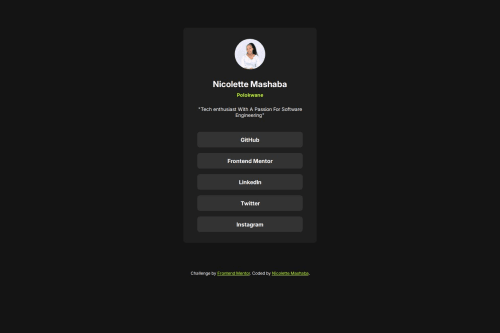Social Media Link Page with HTML and CSS

Solution retrospective
What are you most proud of, and what would you do differently next time?
Proud of:
Successful integration of key features like social media links and responsive design. A clean, user-friendly design with accessibility features. Effective use of HTML, CSS, JavaScript, and Git for version control. What I’d do differently:
Focus more on cross-browser testing and optimization. Improve error handling and project documentation. Gather early user feedback to refine the project in real-time.
What challenges did you encounter, and how did you overcome them?Cross-Browser Compatibility: Issues with styling and responsiveness across browsers. Solution: Used testing tools and CSS fixes to ensure consistency.
Version Control Issues: Problems with Git when pushing changes. Solution: Pruned remotes, deleted corrupted references, and resolved conflicts.
Missing or Broken Assets: Missing fonts and images affecting the design. Solution: Removed unnecessary files and re-uploaded missing assets.
What specific areas of your project would you like help with?Cross-Browser Compatibility Issues: Despite testing, I am still facing minor layout inconsistencies on certain browsers. I would appreciate guidance on best practices to handle these issues, particularly with CSS Grid/Flexbox.
Optimizing Mobile Responsiveness: While the website is responsive, I am looking for tips to make it even more fluid on various screen sizes, especially in the navigation and footer sections.
Git and Version Control Best Practices: I encountered issues with pushing to the remote repository due to broken references. I would like advice on managing large repositories and avoiding similar issues in the future.
Code Documentation: I’m unsure how to properly document the code for better clarity. Could I get some advice on the best practices for writing clear and concise documentation for my project?
Please log in to post a comment
Log in with GitHubCommunity feedback
- @tarun080698
Hello! Great job on completing the solution! While it may not be pixel-perfect, it's a solid effort, and what's most important is that you're on the right path to learning, mastering your skills, and building a strong foundation. Keep going!
For some constructive feedback, I'd recommend focusing a bit more on mastering Flexbox in CSS, especially when it comes to centering elements perfectly from all sides. Paying attention to spacing and ensuring the correct font choice will help refine the design even further.
You're making great progress, and with a few improvements, you'll be well on your way to creating flawless designs. Keep up the fantastic work!
Join our Discord community
Join thousands of Frontend Mentor community members taking the challenges, sharing resources, helping each other, and chatting about all things front-end!
Join our Discord